2006 DODGE RAM SRT-10 check engine
[x] Cancel search: check enginePage 3710 of 5267
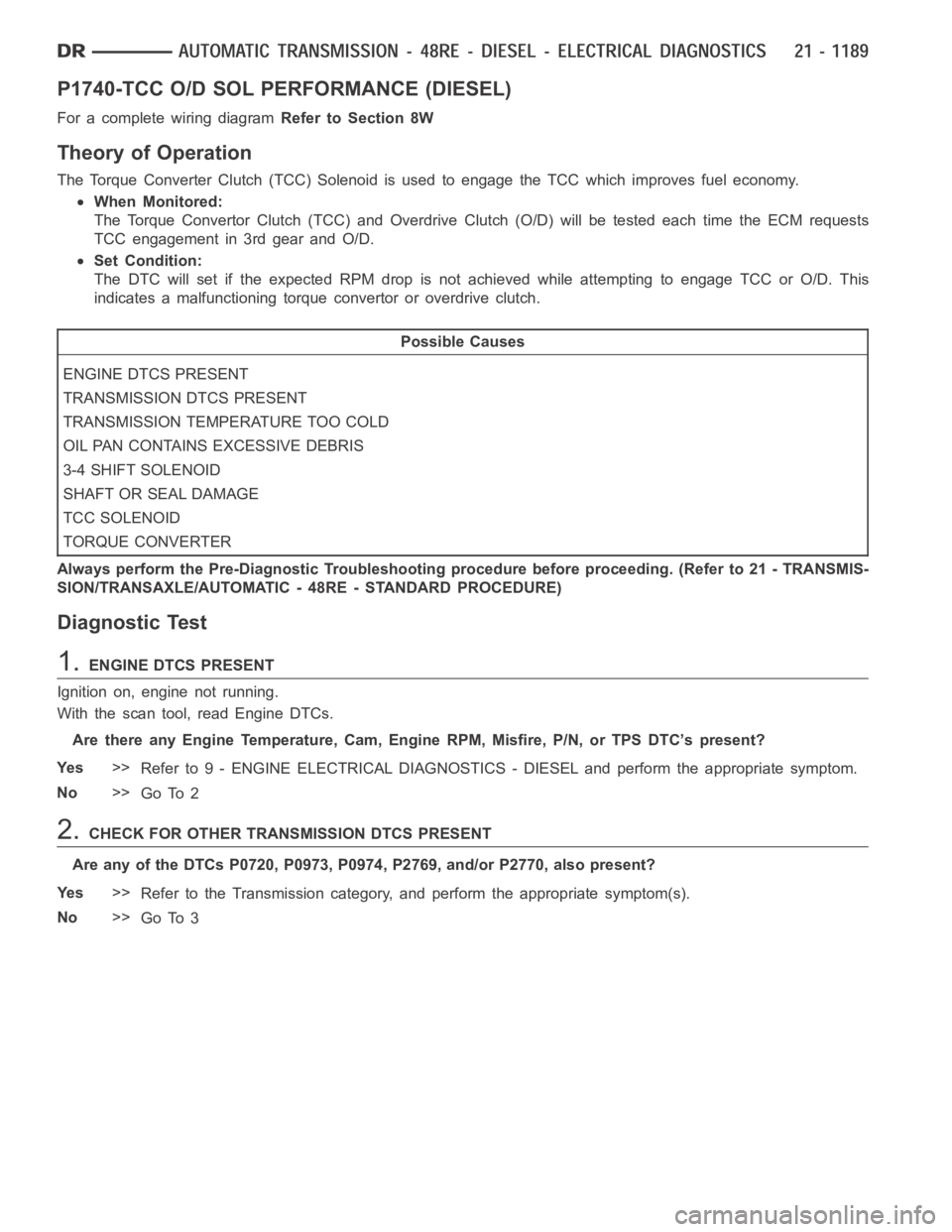
P1740-TCC O/D SOL PERFORMANCE (DIESEL)
For a complete wiring diagramRefer to Section 8W
Theory of Operation
The Torque Converter Clutch (TCC) Solenoid is used to engage the TCC which improves fuel economy.
When Monitored:
The Torque Convertor Clutch (TCC) and Overdrive Clutch (O/D) will be tested each time the ECM requests
TCC engagement in 3rd gear and O/D.
Set Condition:
The DTC will set if the expected RPM drop is not achieved while attempting toengage TCC or O/D. This
indicates a malfunctioning torqueconvertor or overdrive clutch.
Possible Causes
ENGINE DTCS PRESENT
TRANSMISSION DTCS PRESENT
TRANSMISSION TEMPERATURE TOO COLD
OIL PAN CONTAINS EXCESSIVE DEBRIS
3-4 SHIFT SOLENOID
SHAFT OR SEAL DAMAGE
TCC SOLENOID
TORQUE CONVERTER
Always perform the Pre-Diagnostic Troubleshooting procedure before proceeding. (Refer to 21 - TRANSMIS-
SION/TRANSAXLE/AUTOMATIC - 48RE - STANDARD PROCEDURE)
Diagnostic Test
1.ENGINE DTCS PRESENT
Ignition on, engine not running.
With the scan tool, read Engine DTCs.
Are there any Engine Temperature, Cam, Engine RPM, Misfire, P/N, or TPS DTC’s present?
Ye s>>
Refer to 9 - ENGINE ELECTRICAL DIAGNOSTICS - DIESEL and perform the appropriate symptom.
No>>
Go To 2
2.CHECK FOR OTHER TRANSMISSION DTCS PRESENT
Are any of the DTCs P0720, P0973, P0974, P2769, and/or P2770, also present?
Ye s>>
Refer to the Transmission category, and perform the appropriate symptom(s).
No>>
Go To 3
Page 3711 of 5267
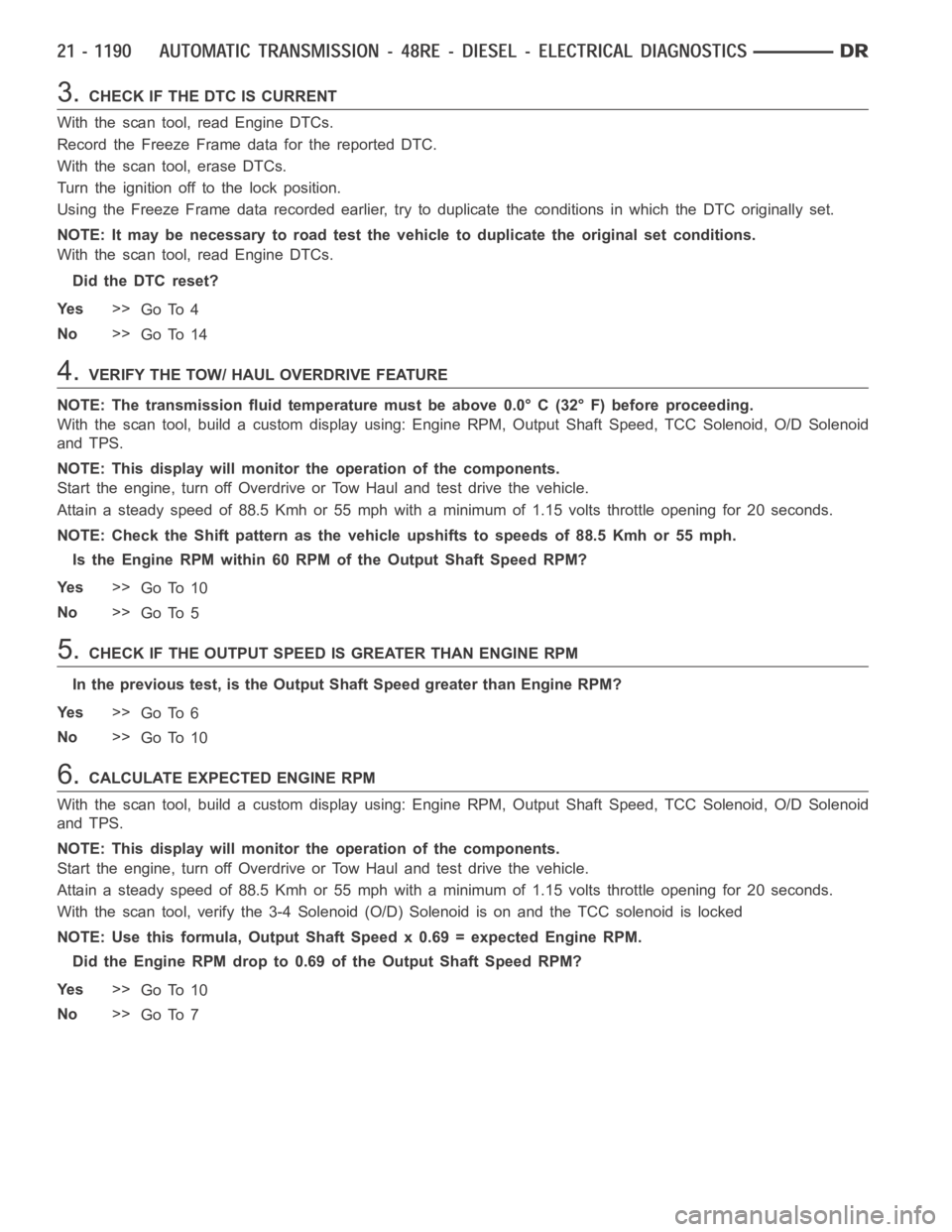
3.CHECK IF THE DTC IS CURRENT
With the scan tool, read Engine DTCs.
Record the Freeze Frame data for the reported DTC.
With the scan tool, erase DTCs.
Turn the ignition off to the lock position.
Using the Freeze Frame data recorded earlier, try to duplicate the conditions in which the DTC originally set.
NOTE: It may be necessary to road test the vehicle to duplicate the originalset conditions.
With the scan tool, read Engine DTCs.
Did the DTC reset?
Ye s>>
Go To 4
No>>
Go To 14
4.VERIFY THE TOW/ HAUL OVERDRIVE FEATURE
NOTE: The transmission fluid temperature must be above 0.0° C (32° F) before proceeding.
With the scan tool, build a custom display using: Engine RPM, Output Shaft Speed, TCC Solenoid, O/D Solenoid
and TPS.
NOTE: This display will monitor the operation of the components.
Start the engine, turn off Overdrive or Tow Haul and test drive the vehicle.
Attain a steady speed of 88.5 Kmh or 55 mph with a minimum of 1.15 volts throttle opening for 20 seconds.
NOTE: Check the Shift pattern as the vehicle upshifts to speeds of 88.5 Kmh or55mph.
Is the Engine RPM within 60 RPM of the Output Shaft Speed RPM?
Ye s>>
Go To 10
No>>
Go To 5
5.CHECK IF THE OUTPUT SPEED IS GREATER THAN ENGINE RPM
In the previous test, is the Output Shaft Speed greater than Engine RPM?
Ye s>>
Go To 6
No>>
Go To 10
6.CALCULATE EXPECTED ENGINE RPM
With the scan tool, build a custom display using: Engine RPM, Output Shaft Speed, TCC Solenoid, O/D Solenoid
and TPS.
NOTE: This display will monitor the operation of the components.
Start the engine, turn off Overdrive or Tow Haul and test drive the vehicle.
Attain a steady speed of 88.5 Kmh or 55 mph with a minimum of 1.15 volts throttle opening for 20 seconds.
With the scan tool, verify the 3-4 Solenoid (O/D) Solenoid is on and the TCC solenoid is locked
NOTE: Use this formula, Output Shaft Speed x 0.69 = expected Engine RPM.
Did the Engine RPM drop to 0.69 of the Output Shaft Speed RPM?
Ye s>>
Go To 10
No>>
Go To 7
Page 3712 of 5267
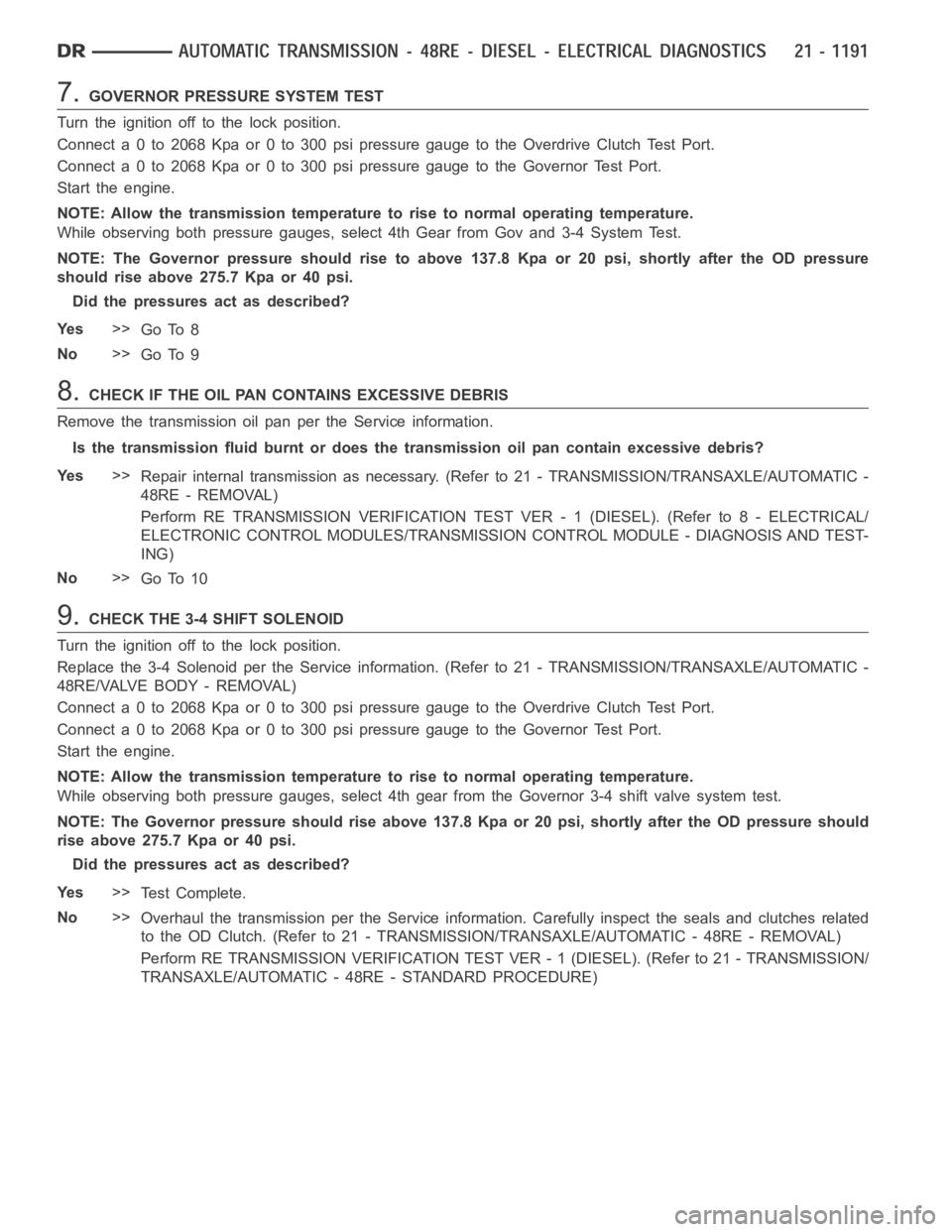
7.GOVERNOR PRESSURE SYSTEM TEST
Turn the ignition off to the lock position.
Connect a 0 to 2068 Kpa or 0 to 300 psi pressure gauge to the Overdrive Clutch Test Port.
Connect a 0 to 2068 Kpa or 0 to 300 psi pressure gauge to the Governor Test Port.
Start the engine.
NOTE: Allow the transmission temperature to rise to normal operating temperature.
While observing both pressure gauges, select 4th Gear from Gov and 3-4 System Test.
NOTE: The Governor pressure should rise to above 137.8 Kpa or 20 psi, shortly after the OD pressure
should rise above 275.7 Kpa or 40 psi.
Did the pressures act as described?
Ye s>>
Go To 8
No>>
Go To 9
8.CHECK IF THE OIL PAN CONTAINS EXCESSIVE DEBRIS
Remove the transmission oil pan per the Service information.
Is the transmission fluid burnt or does the transmission oil pan contain excessive debris?
Ye s>>
Repair internal transmission as necessary. (Refer to 21 - TRANSMISSION/TRANSAXLE/AUTOMATIC -
48RE - REMOVAL)
Perform RE TRANSMISSION VERIFICATION TEST VER - 1 (DIESEL). (Refer to 8 - ELECTRICAL/
ELECTRONIC CONTROL MODULES/TRANSMISSION CONTROL MODULE - DIAGNOSIS ANDTEST-
ING)
No>>
Go To 10
9.CHECK THE 3-4 SHIFT SOLENOID
Turn the ignition off to the lock position.
Replace the 3-4 Solenoid per the Service information. (Refer to 21 - TRANSMISSION/TRANSAXLE/AUTOMATIC -
4 8 R E / VA LV E B O D Y - R E M O VA L )
Connect a 0 to 2068 Kpa or 0 to 300 psi pressure gauge to the Overdrive Clutch Test Port.
Connect a 0 to 2068 Kpa or 0 to 300 psi pressure gauge to the Governor Test Port.
Start the engine.
NOTE: Allow the transmission temperature to rise to normal operating temperature.
While observing both pressure gauges, select 4th gear from the Governor 3-4 shift valve system test.
NOTE: The Governor pressure should rise above 137.8 Kpa or 20 psi, shortly after the OD pressure should
riseabove275.7Kpaor40psi.
Did the pressures act as described?
Ye s>>
Te s t C o m p l e t e .
No>>
Overhaul the transmission per the Service information. Carefully inspect the seals and clutches related
to the OD Clutch. (Refer to 21 - TRANSMISSION/TRANSAXLE/AUTOMATIC - 48RE -REMOVAL)
Perform RE TRANSMISSION VERIFICATION TEST VER - 1 (DIESEL). (Refer to 21 - TRANSMISSION/
TRANSAXLE/AUTOMATIC - 48RE - STANDARD PROCEDURE)
Page 3713 of 5267
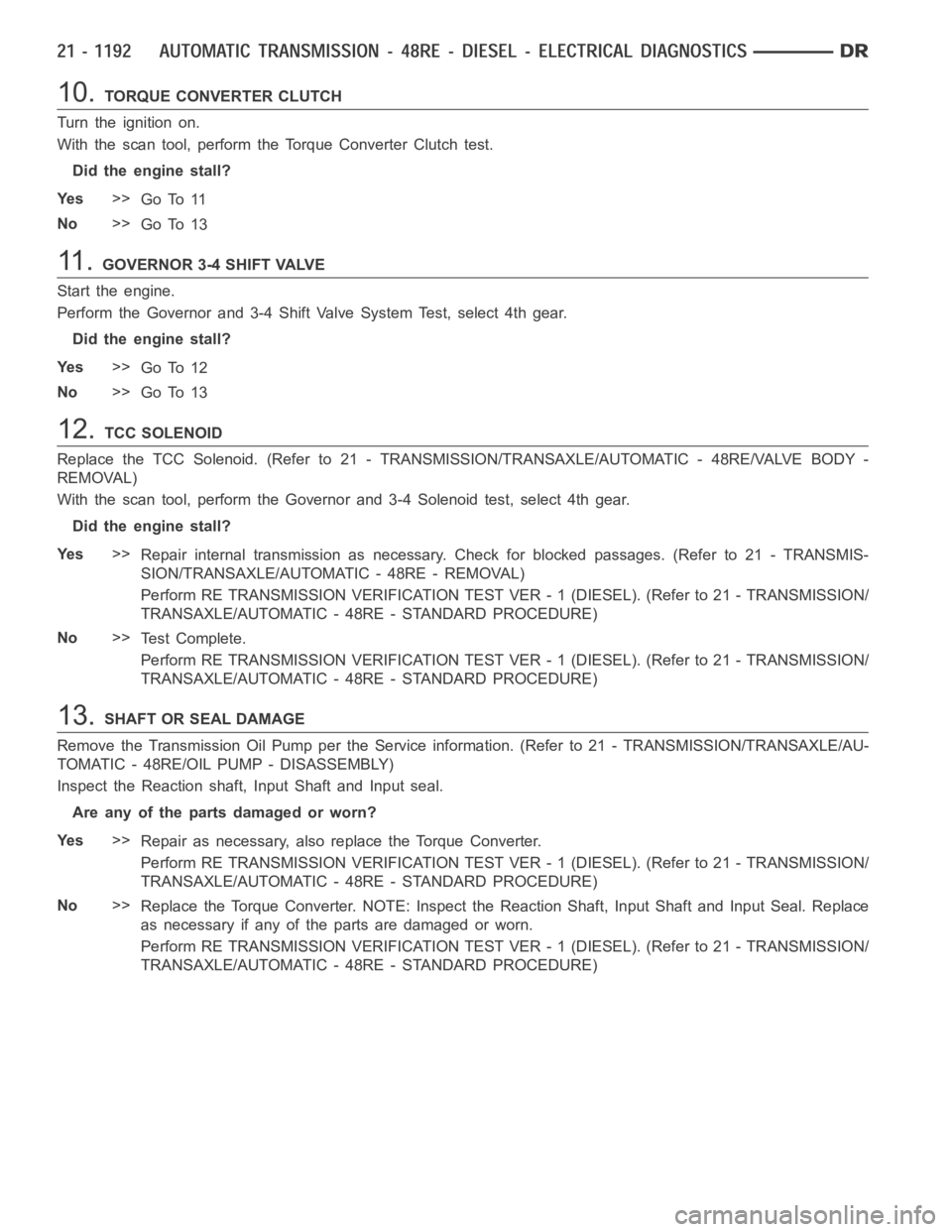
10.TORQUE CONVERTER CLUTCH
Turn the ignition on.
With the scan tool, perform the Torque Converter Clutch test.
Did the engine stall?
Ye s>>
Go To 11
No>>
Go To 13
11 .GOVERNOR 3-4 SHIFT VALVE
Start the engine.
Perform the Governor and 3-4 Shift Valve System Test, select 4th gear.
Did the engine stall?
Ye s>>
Go To 12
No>>
Go To 13
12.TCC SOLENOID
Replace the TCC Solenoid. (Refer to 21 - TRANSMISSION/TRANSAXLE/AUTOMATIC - 48RE/VALVE BODY -
REMOVAL)
With the scan tool, perform the Governor and 3-4 Solenoid test, select 4th gear.
Did the engine stall?
Ye s>>
Repair internal transmission as necessary. Check for blocked passages. (Refer to 21 - TRANSMIS-
SION/TRANSAXLE/AUTOMATIC - 48RE - REMOVAL)
Perform RE TRANSMISSION VERIFICATION TEST VER - 1 (DIESEL). (Refer to 21 - TRANSMISSION/
TRANSAXLE/AUTOMATIC - 48RE - STANDARD PROCEDURE)
No>>
Te s t C o m p l e t e .
Perform RE TRANSMISSION VERIFICATION TEST VER - 1 (DIESEL). (Refer to 21 - TRANSMISSION/
TRANSAXLE/AUTOMATIC - 48RE - STANDARD PROCEDURE)
13.SHAFT OR SEAL DAMAGE
Remove the Transmission Oil Pump per the Service information. (Refer to 21- TRANSMISSION/TRANSAXLE/AU-
TOMATIC - 48RE/OIL PUMP - DISASSEMBLY)
Inspect the Reaction shaft, Input Shaft and Input seal.
Are any of the parts damaged or worn?
Ye s>>
Repair as necessary, also replace the Torque Converter.
Perform RE TRANSMISSION VERIFICATION TEST VER - 1 (DIESEL). (Refer to 21 - TRANSMISSION/
TRANSAXLE/AUTOMATIC - 48RE - STANDARD PROCEDURE)
No>>
Replace the Torque Converter. NOTE: Inspect the Reaction Shaft, Input Shaft and Input Seal. Replace
as necessary if any of the parts are damaged or worn.
Perform RE TRANSMISSION VERIFICATION TEST VER - 1 (DIESEL). (Refer to 21 - TRANSMISSION/
TRANSAXLE/AUTOMATIC - 48RE - STANDARD PROCEDURE)
Page 3716 of 5267
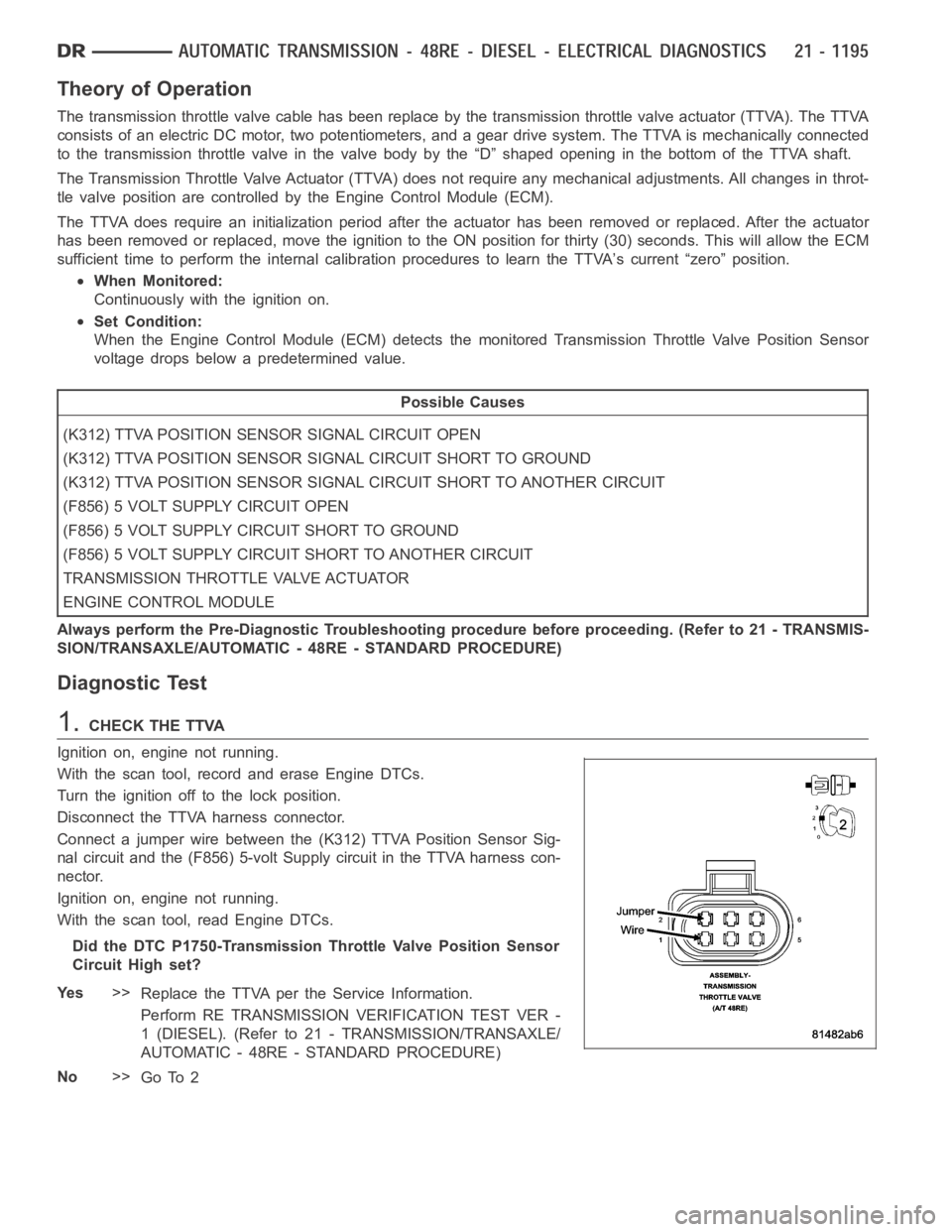
Theory of Operation
The transmission throttle valve cable has been replace by the transmission throttle valve actuator (TTVA). The TTVA
consists of an electric DC motor, two potentiometers, and a gear drive system. The TTVA is mechanically connected
to the transmission throttle valve in the valve body by the “D” shaped opening in the bottom of the TTVA shaft.
The Transmission Throttle Valve Actuator (TTVA) does not require any mechanical adjustments. All changes in throt-
tle valve position are controlled by the Engine Control Module (ECM).
The TTVA does require an initialization period after the actuator has beenremoved or replaced. After the actuator
has been removed or replaced, move the ignition to the ON position for thirty (30) seconds. This will allow the ECM
sufficient time to perform the internal calibration procedures to learn the TTVA’s current “zero” position.
When Monitored:
Continuously with the ignition on.
Set Condition:
When the Engine Control Module (ECM) detects the monitored Transmission Throttle Valve Position Sensor
voltage drops below a predetermined value.
Possible Causes
(K312) TTVA POSITION SENSOR SIGNAL CIRCUIT OPEN
(K312) TTVA POSITION SENSOR SIGNAL CIRCUIT SHORT TO GROUND
(K312) TTVA POSITION SENSOR SIGNAL CIRCUIT SHORT TO ANOTHER CIRCUIT
(F856) 5 VOLT SUPPLY CIRCUIT OPEN
(F856) 5 VOLT SUPPLY CIRCUIT SHORT TO GROUND
(F856) 5 VOLT SUPPLY CIRCUIT SHORT TO ANOTHER CIRCUIT
TRANSMISSION THROTTLE VALVE ACTUATOR
ENGINE CONTROL MODULE
Always perform the Pre-Diagnostic Troubleshooting procedure before proceeding. (Refer to 21 - TRANSMIS-
SION/TRANSAXLE/AUTOMATIC - 48RE - STANDARD PROCEDURE)
Diagnostic Test
1.CHECK THE TTVA
Ignition on, engine not running.
With the scan tool, record and erase Engine DTCs.
Turn the ignition off to the lock position.
Disconnect the TTVA harness connector.
Connect a jumper wire between the (K312) TTVA Position Sensor Sig-
nal circuit and the (F856) 5-volt Supply circuit in the TTVA harness con-
nector.
Ignition on, engine not running.
With the scan tool, read Engine DTCs.
Did the DTC P1750-Transmission Throttle Valve Position Sensor
Circuit High set?
Ye s>>
Replace the TTVA per the Service Information.
Perform RE TRANSMISSION VERIFICATION TEST VER -
1 (DIESEL). (Refer to 21 - TRANSMISSION/TRANSAXLE/
AUTOMATIC - 48RE - STANDARD PROCEDURE)
No>>
Go To 2
Page 3720 of 5267
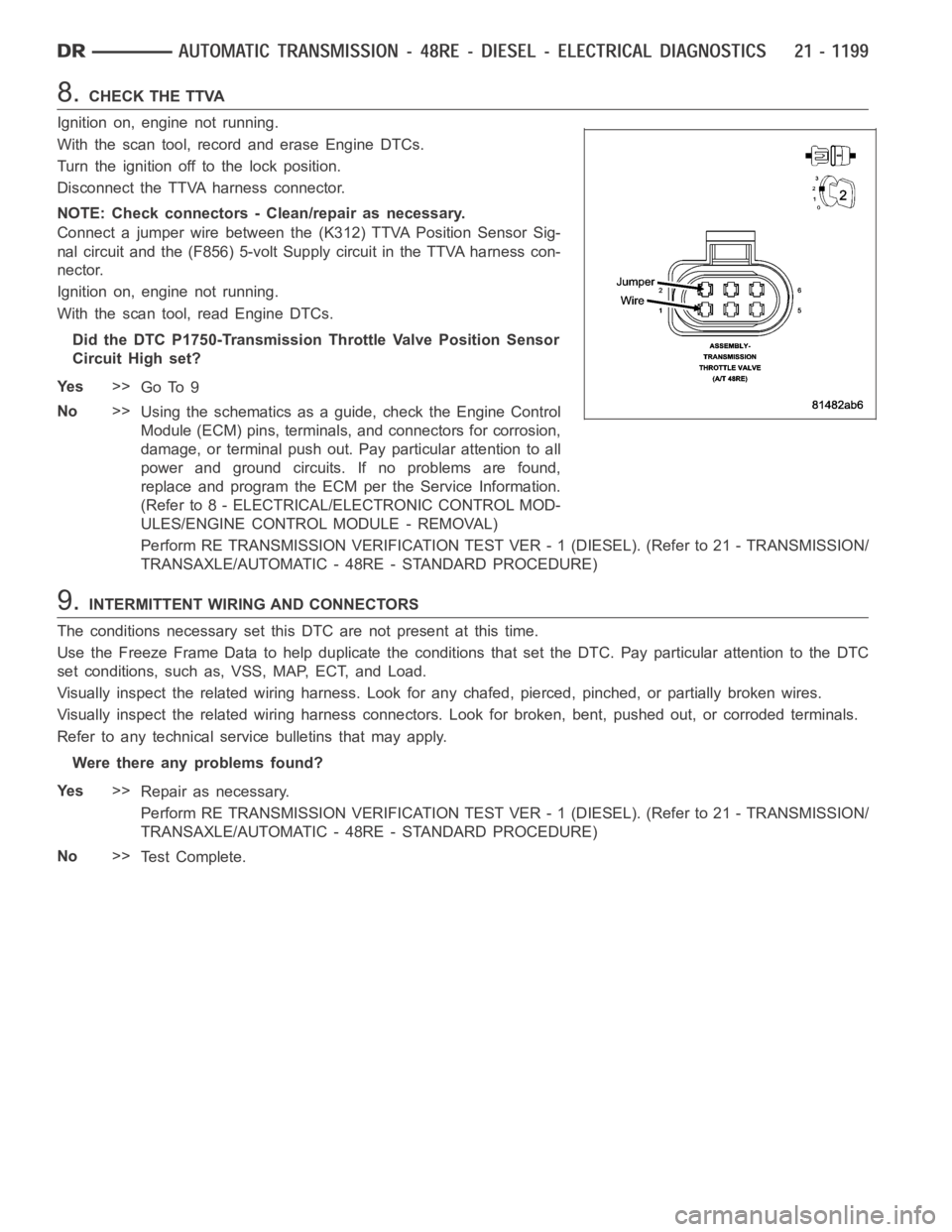
8.CHECK THE TTVA
Ignition on, engine not running.
With the scan tool, record and erase Engine DTCs.
Turn the ignition off to the lock position.
Disconnect the TTVA harness connector.
NOTE: Check connectors - Clean/repair as necessary.
Connect a jumper wire between the (K312) TTVA Position Sensor Sig-
nal circuit and the (F856) 5-volt Supply circuit in the TTVA harness con-
nector.
Ignition on, engine not running.
With the scan tool, read Engine DTCs.
Did the DTC P1750-Transmission Throttle Valve Position Sensor
Circuit High set?
Ye s>>
Go To 9
No>>
Using the schematics as a guide, check the Engine Control
Module (ECM) pins, terminals, and connectors for corrosion,
damage, or terminal push out. Pay particular attention to all
power and ground circuits. If no problems are found,
replace and program the ECM per the Service Information.
(Refer to 8 - ELECTRICAL/ELECTRONIC CONTROL MOD-
ULES/ENGINE CONTROL MODULE - REMOVAL)
Perform RE TRANSMISSION VERIFICATION TEST VER - 1 (DIESEL). (Refer to 21 - TRANSMISSION/
TRANSAXLE/AUTOMATIC - 48RE - STANDARD PROCEDURE)
9.INTERMITTENT WIRING AND CONNECTORS
The conditions necessary set this DTC are not present at this time.
Use the Freeze Frame Data to help duplicate the conditions that set the DTC.Pay particular attention to the DTC
set conditions, such as, VSS, MAP, ECT, and Load.
Visually inspect the related wiring harness. Look for any chafed, pierced, pinched, or partially broken wires.
Visually inspect the related wiring harness connectors. Look for broken,bent, pushed out, or corroded terminals.
Refer to any technical service bulletins that may apply.
Were there any problems found?
Ye s>>
Repair as necessary.
Perform RE TRANSMISSION VERIFICATION TEST VER - 1 (DIESEL). (Refer to 21 - TRANSMISSION/
TRANSAXLE/AUTOMATIC - 48RE - STANDARD PROCEDURE)
No>>
Te s t C o m p l e t e .
Page 3722 of 5267
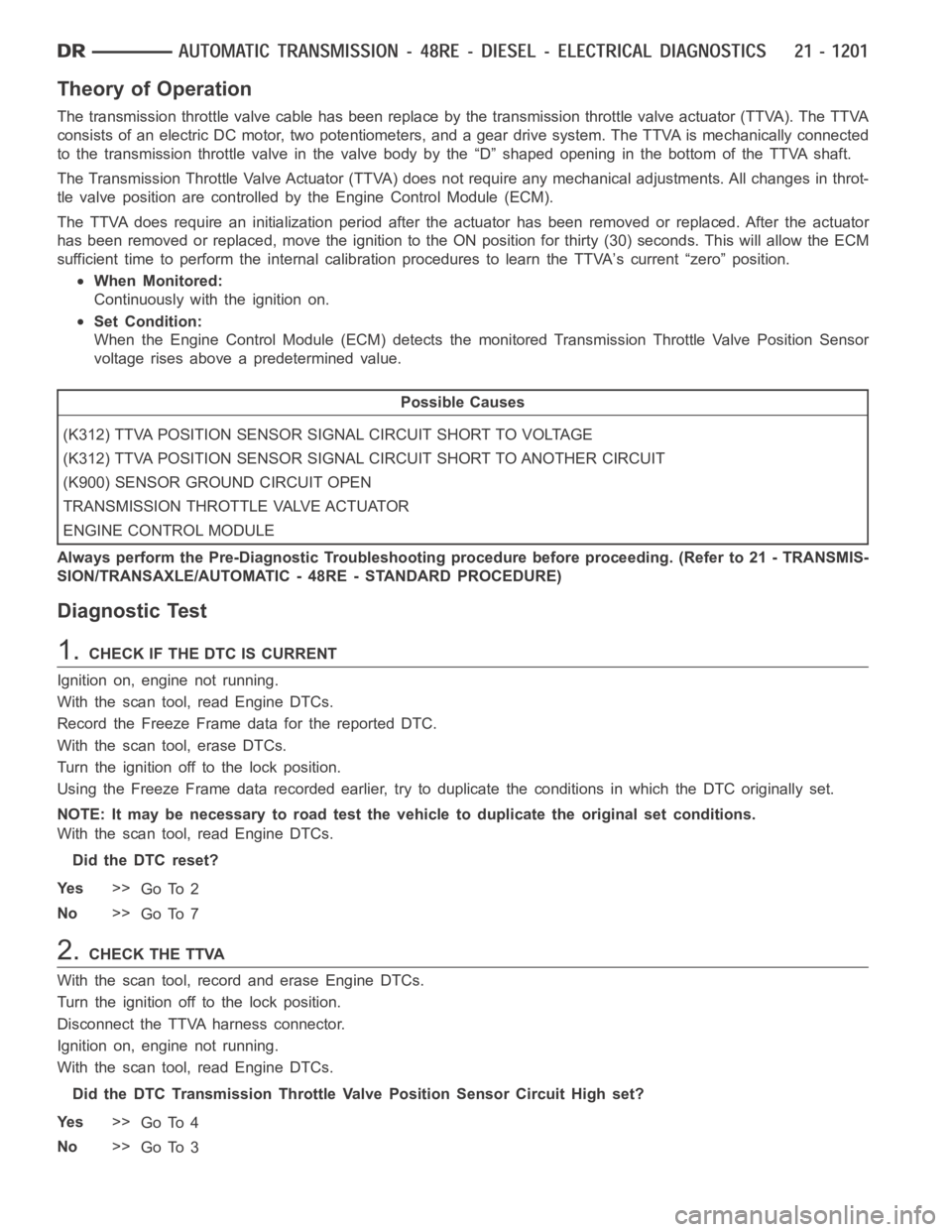
Theory of Operation
The transmission throttle valve cable has been replace by the transmission throttle valve actuator (TTVA). The TTVA
consists of an electric DC motor, two potentiometers, and a gear drive system. The TTVA is mechanically connected
to the transmission throttle valve in the valve body by the “D” shaped opening in the bottom of the TTVA shaft.
The Transmission Throttle Valve Actuator (TTVA) does not require any mechanical adjustments. All changes in throt-
tle valve position are controlled by the Engine Control Module (ECM).
The TTVA does require an initialization period after the actuator has beenremoved or replaced. After the actuator
has been removed or replaced, move the ignition to the ON position for thirty (30) seconds. This will allow the ECM
sufficient time to perform the internal calibration procedures to learn the TTVA’s current “zero” position.
When Monitored:
Continuously with the ignition on.
Set Condition:
When the Engine Control Module (ECM) detects the monitored Transmission Throttle Valve Position Sensor
voltage rises above a predetermined value.
Possible Causes
(K312) TTVA POSITION SENSOR SIGNAL CIRCUIT SHORT TO VOLTAGE
(K312) TTVA POSITION SENSOR SIGNAL CIRCUIT SHORT TO ANOTHER CIRCUIT
(K900) SENSOR GROUND CIRCUIT OPEN
TRANSMISSION THROTTLE VALVE ACTUATOR
ENGINE CONTROL MODULE
Always perform the Pre-Diagnostic Troubleshooting procedure before proceeding. (Refer to 21 - TRANSMIS-
SION/TRANSAXLE/AUTOMATIC - 48RE - STANDARD PROCEDURE)
Diagnostic Test
1.CHECK IF THE DTC IS CURRENT
Ignition on, engine not running.
With the scan tool, read Engine DTCs.
Record the Freeze Frame data for the reported DTC.
With the scan tool, erase DTCs.
Turn the ignition off to the lock position.
Using the Freeze Frame data recorded earlier, try to duplicate the conditions in which the DTC originally set.
NOTE: It may be necessary to road test the vehicle to duplicate the originalset conditions.
With the scan tool, read Engine DTCs.
Did the DTC reset?
Ye s>>
Go To 2
No>>
Go To 7
2.CHECK THE TTVA
With the scan tool, record and erase Engine DTCs.
Turn the ignition off to the lock position.
Disconnect the TTVA harness connector.
Ignition on, engine not running.
With the scan tool, read Engine DTCs.
Did the DTC Transmission Throttle Valve Position Sensor Circuit High set?
Ye s>>
Go To 4
No>>
Go To 3
Page 3723 of 5267

3.CHECK THE (K900) SENSOR GROUND CIRCUIT FOR AN OPEN
Ignition on, engine not running.
With the scan tool, record and erase Engine DTCs.
Turn the ignition off to the lock position.
Disconnect the TTVA harness connector.
NOTE: Check connectors - Clean/repair as necessary.
Connect a jumper wire between the (K900) Sensor Ground circuit and
the (F856) 5-volt Supply circuit in the TTVA harness connector.
Ignition on, engine not running.
With the scan tool, read Engine DTCs.
Did either P0642 or P0652 Sensor Supply Voltage DTC set?
Ye s>>
Replace the TTVA per the Service Information.
Perform RE TRANSMISSION VERIFICATION TEST VER -
1 (DIESEL). (Refer to 21 - TRANSMISSION/TRANSAXLE/
AUTOMATIC - 48RE - STANDARD PROCEDURE)
No>>
Repair the (K900) TTVA Sensor Ground circuit for an open.
Perform RE TRANSMISSION VERIFICATION TEST VER - 1 (DIESEL). (Refer to 21 - TRANSMISSION/
TRANSAXLE/AUTOMATIC - 48RE - STANDARD PROCEDURE)
4.CHECK THE (K312) TTVA POSITION SENSOR SIGNAL CIRCUIT FOR A SHORT TO VOLTAGE
Turn the ignition off to the lock position.
Disconnect the ECM C1 and C2 harness connectors.
Ignition on, engine not running.
Measure the voltage of the (K312) TTVA Position Sensor Signal circuit.
Is the voltage above 0.5 volts?
Ye s>>
Repair the (K312) TTVA Position Sensor Signal circuit for a
short to voltage.
Perform RE TRANSMISSION VERIFICATION TEST VER -
1 (DIESEL). (Refer to 21 - TRANSMISSION/TRANSAXLE/
AUTOMATIC - 48RE - STANDARD PROCEDURE)
No>>
Go To 5